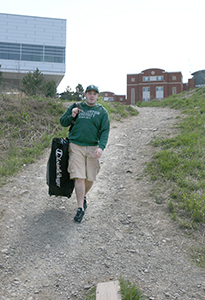
After constant resistance from administration officials, residential community government leaders have obtained permission to use their money to partially fund the paving of what is currently Mountainview’s dirt path.
According to Jordan Stern, president of Mountainview College and a sophomore majoring in mechanical engineering, the first engineering report estimated that the maintenance and building costs of the path would be around $400,000 over 20 years.
Still, the seven residential communities agreed that $45,000 of the $60,000 they were collectively given this year for community improvements should go to paving the Mountainview path.
The path stretches from the bottom of Lot W through the partially-torn link fence to the stairs leading to the Appalachian Collegiate Center, Mountainview’s dining hall.
Community presidents have met with administration members Brian Rose, vice president for student affairs, and James Van Voorst, vice president for administration. The first time, they were told the money could not be used for this project. The second time, administration agreed to put the money aside for a paved path.
According to Rose, the administration has agreed to hold the community’s money for the path project, but that money is only a small percentage of the anticipated costs.
Student Association President Adam Amit said he is unsure as to why the administration doesn’t think the expenses of building and maintaining the path are outweighed by the benefits.
“There are always more good ideas for campus improvements than there is money available to fund them, so every year good projects go unrealized,” Rose said.
Mountainview faculty master Robert Emerson put together a slideshow demonstrating the benefits of paving the pathway. These benefits include an increase in the use of the Appalachian Dining Hall and Mountainview’s upper lot, among other things.
The slideshow states that the University’s safety committee has deemed this path as the top safety issue on campus.
According to the engineering report, 90 seconds are saved each time a student uses the path for a round trip.
“When you add up that 95 percent of the community uses this path about 2.5 times a day, over the 20-year period projected in the engineering report there is nearly 11,000 hours lost,” Stern said.
Amit said he believes when students come together, they hold a lot of power and that this situation is a perfect example of that.
Stern echoed Amit, adding that Mountainview is indebted to the other communities for their support.
“The support from other communities has been tremendous, and this shows that the issue isn’t one that is affecting the Mountainview community alone, it is a campus-wide feeling that this path should be fixed,” Stern said.
Rose said the administration will continue to look for opportunities to fund the path and include it in the planning documents of future campus construction.


